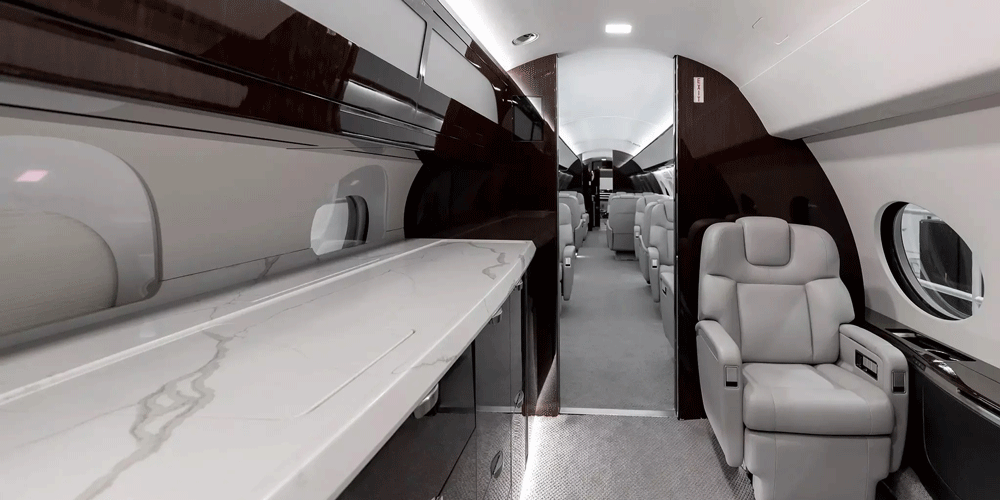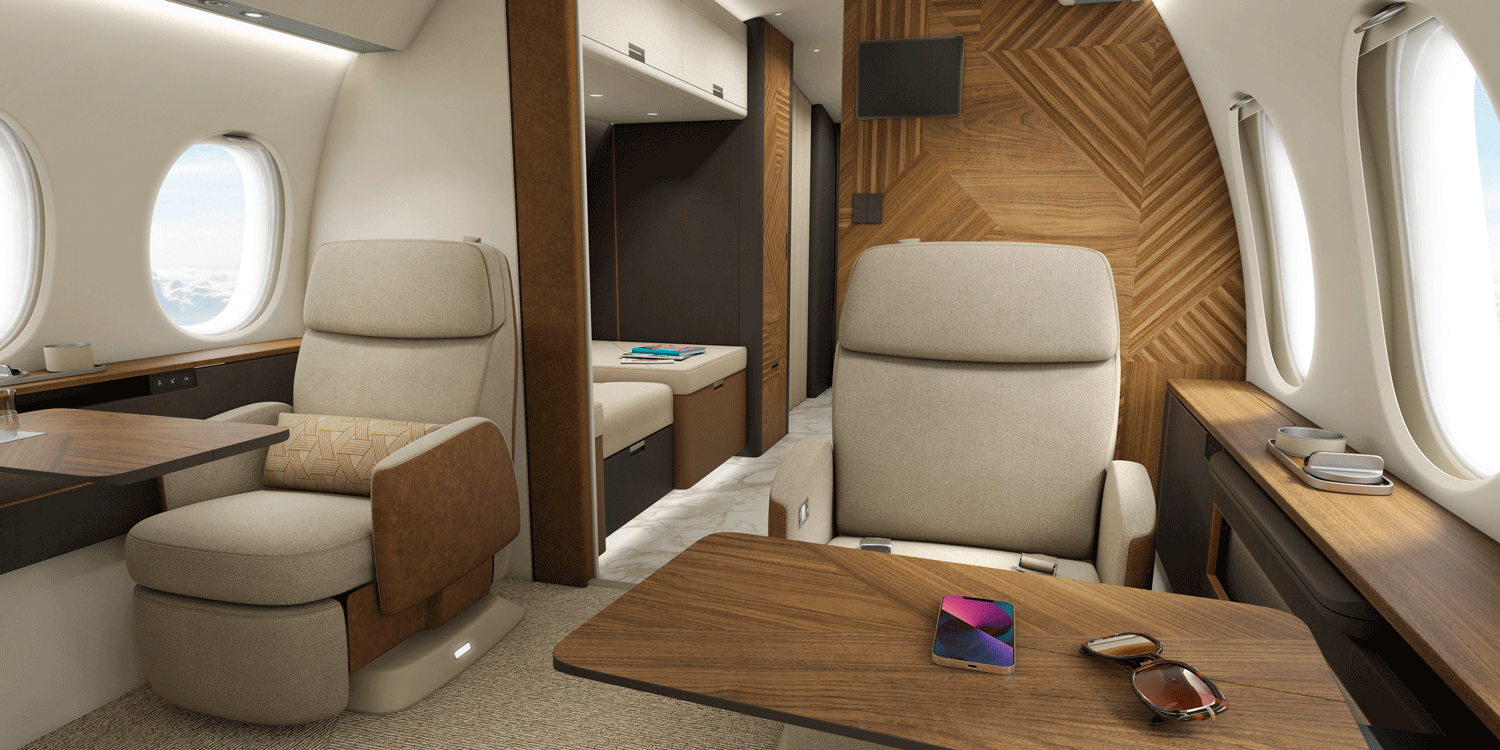Click Here to View This Page on Production Frontend
Click Here to Export Node Content
Click Here to View Printer-Friendly Version (Raw Backend)
Note: front-end display has links to styled print versions.
Content Node ID: 413740
If you’re looking for proof of sustainability in business aviation this week at EBACE 2023, look no further than the cabins of the aircraft in the static display at Geneva Airport and the interior components presented by completion and refurbishment specialists exhibiting at Palexpo.
While the industry’s focus on sustainability developed relatively recently, cabin interiors have relied on sustainable materials and renewable resources “for decades,” said Christi Tannahill, sr. v-p, customer experience, at Textron Aviation (Booth T26, Static Display AD_07). She cited the wool, cotton, linen, silk, mohair, bamboo, and leather commonly used to outfit business aircraft cabins, all of which are sustainable and renewable.
Now manufacturers and interior specialists are redoubling their efforts to make cabins even greener, lowering the aircraft’s carbon footprint over their lifetimes, while showcasing what designers and engineers can achieve on the path to carbon neutrality.
The Global and Challenger business jet cabins made by Canada’s Bombardier (Booth K40, Static Display AD_09) feature “a range of upcycled and engineered soft goods made from reclaimed or natural fibers,” said Laurence Casia, Bombardier's manager of industrial design and cabin innovation. Many of the items featured are on the airframer's super-midsize Challenger 3500, which entered service last year.
Gulfstream Aerospace's (Booth S120, Static Display AD_08) business jet cabins are likewise outfitted with materials “derived from renewable resources,” said company president Mark Burns, while interior components are also largely recyclable. Honeycomb aluminum used in cabin structures can go directly to smelters, for example, while fabrics and carpeting become industrial raw materials. But, Burns added, “Part of our approach to reducing environmental impact at Gulfstream is to design aircraft that have long service lives to mitigate the need to consume resources to build replacement aircraft.”

That’s a point echoed by other OEMs and underscored by the average age of in-service jets, which exceeded 18 years in 2022—another benchmark of sustainability.
Dassault Falcon (Booth Z72, Static Display AD_02) cabins also incorporate fabrics, wood, vegetal-tanned leathers, and other renewable and environmentally friendly materials throughout. Additionally, the Falcon 10X, slated to enter service in 2025, is designed with modular interior elements to enhance sustainable maintenance. “If there’s an issue with a cabinet, for example, it’s easy to repair or modify without having to replace substantial interior components,” said Vadim Felzer, head of the French aerospace company’s global communications.

Dassault’s colors, materials, and finishing design studio recently created a unique palette of materials that include undyed wool carpet designs, featuring colors of the natural world: shades of light and dark beige, as well as other subtle earth tones, that in their raw beauty may vary slightly from one batch to another. Dassault emphasizes the subtle contrasts through a unique weaving technique and is the first aircraft manufacturer to offer this pattern alternative for new cabin installations.

Textron (Booth T26, Static Display AD_07), which manufactures Cessna, Beechcraft, and Bell aircraft, introduced a demonstrator aircraft for the refreshed midsize Cessna Citation XLS Gen2 last year at EBACE that featured an “eco-friendly interior” with organic, natural, and biodegradable fabrics and leathers, along with reconstituted veneer. Explaining these options “helps customers discover how they can create their dream interior, while also being eco-conscious,” said Tannahill.

Meanwhile, manufacturers report that ”more private aviation customers are becoming aware of sustainable materials and requesting them when it comes to cabin design,” said Casia at Bombardier. Moreover, that demand comes “from customers around the world,” Tannahill said.
Indeed, the increasing application of sustainable natural fibers and more common woods is creating “a new aesthetic that appeals to many customers,” said Felzer at Dassault. “They feel good about the material choices and love the feeling and overall cabin environment that natural materials make possible.”
Moreover, these cabins prove that "sustainability doesn’t mean having to make any compromises,” said Casia, noting that rapidly renewable wood options for cabin surfaces and locally sourced fiber-based materials “are as comfortable and luxurious as they are sustainable.” Equally important for sustainability, they are “often more durable and lightweight” than the materials they replace, he said, helping lower fuel consumption.
“Sustainability, quality, and craftsmanship are without a doubt compatible,” echoed Gulfstream’s Burns. “Natural materials at their best are typically also the finest.”
Demand for sustainability is also seen in the VIP custom interior market. Airbus Corporate Helicopters (Booth Z52, Static Display AD_03), sibling of the VIP airframer Airbus Corporate Jets, last year delivered an ACH145 light twin outfitted with a “fully vegan” interior. The leather elements are replaced by synthetic Ultraleather, which looks, feels, and wears like leather—though it’s not as easy to work. Said ACH head Frederic Lemos, “We found a practical way to meet our customer's desires, which also looks superb.”
The ACH145 buyer, German entrepreneur Urs Brunner, is married to ethical fashion pioneer Daniela Brunner. Her label uses no animal products in its offerings and donates all profits toward animal welfare.
At its Basel, Switzerland completions center, Jet Aviation (Booth E50) is “offering our customers a range of sustainable choices” and integrating “more sustainable materials into VVIP cabin design,” said v-p of completions sales and marketing Matthew Woollaston. Monuments, fixtures, furnishings, and finishes are all fair game for greening.
The company’s recent “Mink” VIP cabin concept includes table marquetry made of marble offcuts, complementing natural fiber fabrics and flooring made from recycled materials. Jet Aviation has also focused on creating lighter cabins, reducing emissions by cutting fuel burn, and its engineering and production teams are exploring advanced composite materials for interior applications. In the fall, Jet Aviation redelivered its lightest and quietest aircraft to date as it seeks “balance between creating the optimal sound experience and reducing cabin weight for our customers.”
For the forthcoming BBJ777X, which will have the largest interior of any production aircraft aimed at the business aviation market, U.S.-based Boeing completion specialist Greenpoint Technologies (Booth A72) recently introduced the “Zen” interior design concept, featuring many sustainable and biophilic design elements.
Throughout the interior, glass-enclosed jewel box gardens equipped with atmospheric climate control house organic plants and pebbles. Bringing such elements inside the cabin can increase awareness of sustainability and sustainable material options, according to Greenpoint, while creating “a healthier cabin and meditative environment that encourages connection with nature.”
The Zen interior concept also features reclaimed walnut veneer, natural recycled fabrics, and leather engineered to be lightweight and have a low environmental impact; the leather is one example of formerly “unsuitable, unsustainable, or unattainable” materials that have been transformed by technology into “increasingly lightweight and eco-friendly” choices for cabin interiors, the company said.

MRO and completion specialist Lufthansa Technik (Booth H72), which has recently introduced innovations including ultra-thin curved OLED screens that save weight and energy, has added sustainable materials to its list of VIP interiors options. AeroFlax, among the latest from the German company, is a flax-based replacement material for glass or carbon fiber parts such as sidewalls and ceiling panels, offering a 20 percent weight savings over glass or carbon, along with low density and desirable mechanical properties for use in aircraft interiors.

Not only are sustainable interiors better for the environment, but they can also cost less thanks to the minimal processing and lower shipping costs of renewable and locally sourced materials. But the real payback is “avoiding emissions and waste, through judicious choices of more sustainable materials, which will ultimately benefit us and our planet,” Bombardier's Casia concluded.